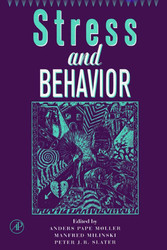Suchen und Finden
Service
Advances in the Study of Behavior - Stress and Behavior
Peter J.B. Slater, Milinski Manfred, Anders Pape M?ller
Verlag Elsevier Textbooks, 1998
ISBN 9780080582887 , 569 Seiten
Format PDF, ePUB, OL
Kopierschutz DRM
Geräte
Front Cover
1
Stress and Behavior
4
Copyright Page
5
Contents
6
Contributors
10
Preface
12
Introduction
14
Chapter 1. The Concept of Stress and Its Relevance for Animal Behavior
18
I. Introduction
18
II. The Concept of Stress
19
III. Social Stress in Mammals
59
IV. Summary
123
References
126
Chapter 2. Stress and Immune Response
150
I. Introduction
150
II. The Nature of Stress
151
III. The Nature of Immunocompetence
153
IV. Neurological Linking of Stress and Immunocompetence
157
V. Endocrine Linkage of Stress and Immunocompetence
159
Vl. Why Stress Alters Immunocompetence
162
VII. Summary
166
References
167
Chapter 3. Behavioral Variability and Limits to Evolutionary Adaptation under Stress
172
I. Introduction
172
II. Energy Limits to Adaptation
175
III. Variability and the Survival of Variants
181
IV. Extending the Limits of Adaptation
182
V. From Stress-Resistance Genotypes to a Connected Metabolism
186
VI. Summary
191
References
191
Chapter 4. Developmental Instability as a General Measure of Stress
198
I. Introduction
198
II. Genetic and Environmental Determinants of Developmental Instability
203
III. Directional Selection and Developmental Instability
207
IV. Fitness Correlates of Developmental Instability
209
V. Practical Uses of Developmental Instability
210
VI. Conclusions and Prospects for Future Studies
223
VII. Summary
225
References
225
Chapter 5. Stress and Decision-Making under the Risk of Predation: Recent Developments from Behavioral, Reproductive, and Ecological Perspectives
232
I. Introduction
232
II. Behavior of Feeding Animals: Classical Motivations
234
III. Patterns of Activity
242
IV. After an Encounter with a Predator
252
V. Social Situations
256
VI. Reproduction
258
VII. Long-Term Consequences of Decision Making
262
VIII. Ecological Influences and Implications
265
IX. Additional Considerations
278
X. Conclusions and Summary
281
References
282
Chapter 6. Parasitic Stress and Self-Medication in Wild Animals
308
I. Introduction
308
II. Self-Medication
310
III. Prophylactic Self Medication
311
IV. Therapeutic Self-Medication
315
V. Skepticism
320
VI. Behavioral Mechanisms
321
VII. Implications
325
VIII. Summary and Conclusions
327
References
328
Chapter 7. Stress and Human Behavior: Attractiveness, Women’s Sexual Development, Postpartum Depression, and Baby’s Cry
336
I. Introduction
336
II. Human Attraction and Attractiveness
338
III. Parent–Daughter Relations and Women’s Sexual Behavior
349
IV. Postpartum Depression
358
V. Infant Crying as a Signal of Phenotypic Quality
369
VI. Summary
373
References
376
Chapter 8. Welfare, Stress, and the Evolution of Feelings
388
I. Feelings, Their Role and Their Evolution
388
II. Welfare, Stress, and Feelings
411
III. Summary
417
References
418
Chapter 9. Biological Conservation and Stress
422
I. Introduction
422
II. Stress in a Conservation Biology Context
424
III. Designing a Conservation Study to Measure Stress and Its Impact
437
IV. The Natural History of Stress
445
V. Effects of Anthropogenic Stressors
469
VI. Conservation Research and Management Activities as Stressors
490
VII. The Equivalence of Natural and Anthropogenic Stressors
503
VIII. Minimizing Occurrence and Impact of Stress in Conservation Research and Management
505
IX. Conclusions: How Important Is Stress in Biological Conservation?
511
X. Summary
513
References
514
Index
544
Contents of Previous Volumes
566
Service
Shop



